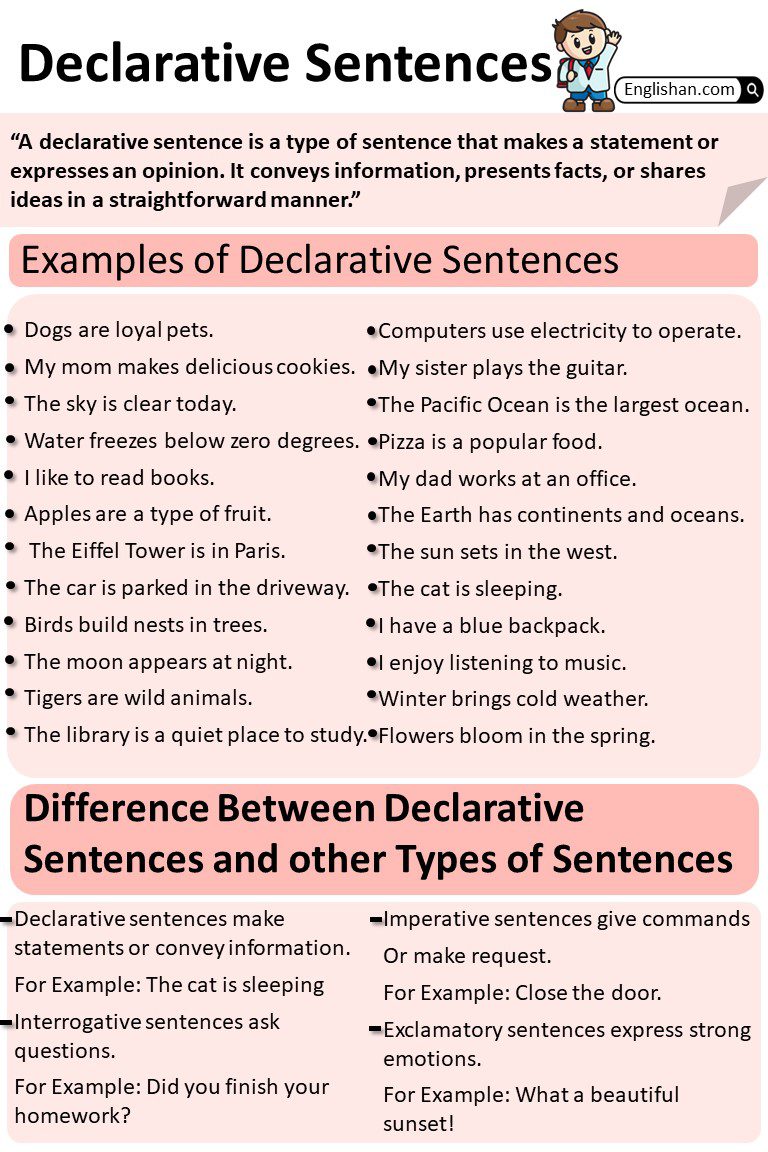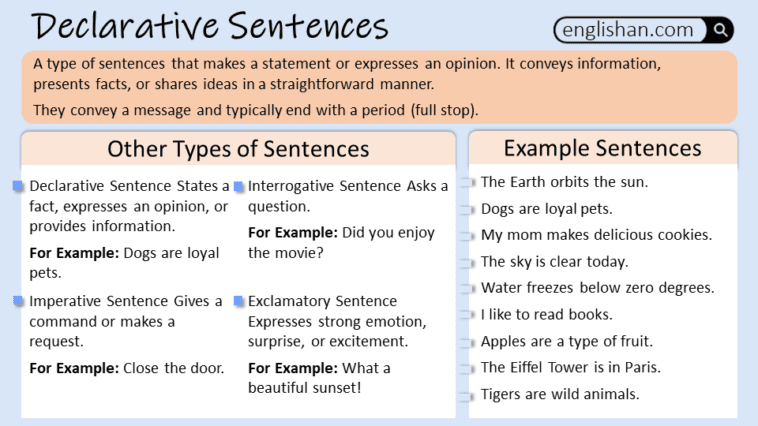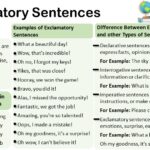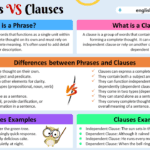Declarative sentences are a type of sentence that makes a statement or expresses an opinion. They convey information, share facts, or present ideas. Declarative sentences typically end with a period and have a straightforward structure.
What Is a Declarative Sentence?
A declarative sentence is a type of sentence that makes a statement or expresses an opinion. It conveys information, presents facts, or shares ideas in a straightforward manner. Declarative sentences are the most common type of sentence in the English language, and they serve to communicate information clearly. These sentences typically end with a period (full stop).
Key characteristics of declarative sentences include:
1. Subject and Predicate: Like any sentence, a declarative sentence consists of a subject and a predicate. The subject is what the sentence is about, and the predicate provides information about the subject through a verb and often an object.
- Example: Birds sing beautifully. (Subject: Birds; Predicate: sing beautifully)
2. Statement of Fact or Opinion: Declarative sentences are used to state facts or express opinions. They are not used for asking questions, giving commands, or making exclamations.
- Example: The Earth revolves around the sun.
3. Ends with a Period: Declarative sentences conclude with a period (.) punctuation mark. This distinguishes them from other types of sentences.
- Example: I enjoy reading novels. (ends with a period)
4. Objective Tone: Declarative sentences typically have a neutral or objective tone. They present information without expressing strong emotions or urgency.
- Example: Paris is the capital of France.

Definition of a Declarative Sentence
A declarative sentence is a type of sentence that makes a statement or expresses an opinion. Its primary function is to convey information, present facts, or share ideas in a straightforward manner. Declarative sentences are the most common sentence type in the English language, and they typically end with a period (full stop).
Examples of Declarative Sentences
Here are some examples of declarative sentences:
- The Earth orbits the sun.
- Dogs are loyal pets.
- My mom makes delicious cookies.
- The sky is clear today.
- Water freezes below zero degrees.
- I like to read books.
- Apples are a type of fruit.
- The Eiffel Tower is in Paris.
- The car is parked in the driveway.
- Birds build nests in trees.
- The moon appears at night.
- Tigers are wild animals.
- I enjoy listening to music.
- Winter brings cold weather.
- Flowers bloom in the spring.
- The library is a quiet place to study.
- Computers use electricity to operate.
- My sister plays the guitar.
- The Pacific Ocean is the largest ocean.
- Pizza is a popular food.
- My dad works at an office.
- The Earth has continents and oceans.
- The sun sets in the west.
- The cat is sleeping.
- I have a blue backpack.
Structure and Punctuation of Declarative Sentences
The structure and punctuation of a declarative sentence are essential components that contribute to its clarity and effectiveness in communication. Here’s a breakdown of the typical structure and punctuation of a declarative sentence:
Structure:
Subject:
- The subject is the part of the sentence that indicates what or whom the sentence is about.
- It can be a noun, pronoun, or noun phrase.
- Example: Cats are independent animals.
Predicate:
- The predicate is the part of the sentence that provides information about the subject.
- It includes a verb and may also include an object.
- Example: Cats are independent animals.
Punctuation:
Ends with a Period:
- It always ends with a period (full stop).
- The period signals the completion of a thought or statement.
- Example: I enjoy reading books.
Capitalization:
- The first word of its is always capitalized.
- Example: The sun rises in the east.
Example:
- Declarative Sentence: The sun sets in the west.
In this example:
- Subject: The sun
- Predicate: sets in the west
- Punctuation: Ends with a period.
Difference Between Declarative Sentences and Other Types of Sentences
There are four main types, interrogative, imperative, and exclamatory. Each type serves a different purpose in communication. Here’s a brief overview of the differences between declarative sentences and the other three types:
1. Declarative Sentence:
- Purpose: States a fact, expresses an opinion, or provides information.
- Structure: Subject + Predicate.
- Punctuation: Ends with a period (full stop).
- Example: Dogs are loyal pets.
2. Interrogative Sentence:
- Purpose: Asks a question.
- Structure: Inverts the normal subject-predicate order or uses a question word.
- Punctuation: Ends with a question mark.
- Example: Did you enjoy the movie?
3. Imperative Sentence:
- Purpose: Gives a command or makes a request.
- Structure: Often lacks an explicit subject (you is understood).
- Punctuation: Ends with a period or exclamation mark.
- Example: Close the door.
4. Exclamatory Sentence:
- Purpose: Expresses strong emotion, surprise, or excitement.
- Structure: Similar to declarative or imperative but with an exclamation point.
- Punctuation: Ends with an exclamation mark.
- Example: What a beautiful sunset!
Common words used in Declarative Sentences
In declarative sentences, common words are used to convey information, express opinions, or make statements. Here are some common words frequently found in declarative sentences:
1. Nouns:
- Identify people, places, things, or ideas.
- Example: Dogs make great companions.
2. Verbs:
- Express actions or states of being.
- Example: She plays the piano.
3. Adjectives:
- Describe or modify nouns.
- Example: The house has a blue door.
4. Adverbs:
- Modify verbs, adjectives, or other adverbs.
- Example: He runs quickly.
5. Pronouns:
- Replace nouns to avoid repetition.
- Example: She loves chocolate.
6. Conjunctions:
- Connect words, phrases, or clauses.
- Example: I like both tea and coffee.
7. Prepositions:
- Show relationships between words in time or space.
- Example: The book is on the shelf.
8. Articles:
- Specify or limit nouns.
- Example: A cat is in the garden.
9. Determiners:
- Introduce or specify nouns.
- Example: This is my favorite book.
10. Auxiliary Verbs (Helping Verbs):
- Assist the main verb in forming tenses or expressing modality.
- Example: She is reading a book.
11. Quantifiers:
- Indicate quantity or amount.
- Example: I have some friends.
12. Negation Words:
- Express negation or denial.
- Example: He does not like spinach.
13. Intensifiers:
- Emphasize the degree or extent of an action or adjective.
- Example: It’s very hot outside.
14. Time Expressions:
- Indicate when an action occurs.
- Example: We will meet tomorrow.
Points to Remember When Using Declarative Sentences
When using declarative sentences, it’s important to keep certain points in mind to ensure effective communication. Here are some key points to remember:
1. Statement of Fact or Opinion:
These are used to state facts, express opinions, or provide information. Ensure that your sentence conveys a clear and accurate message.
2. Clear Subject and Predicate:
Clearly identify the subject and predicate in your sentence to maintain clarity. This helps your audience understand what the sentence is about and what action or information is being conveyed.
3. End with a Period:
It always ends with a period. This punctuation mark indicates the completion of a thought and distinguishes declarative sentences from other sentence types.
4. Use Objective Tone:
Maintain an objective and neutral tone in it. While expressing opinions is allowed, avoid overly emotional language and present information in a straightforward manner.
5. Correct Grammar and Syntax:
Ensure proper grammar and syntax in your declarative sentences. Pay attention to subject-verb agreement, word order, and overall sentence structure to enhance readability.
6. Avoid Ambiguity:
Be clear and specific in your declarative statements. Avoid vague language or ambiguous terms that could lead to confusion.
7. Use Supporting Details:
When necessary, include supporting details to strengthen your declarative statements. This can help provide context or evidence for the information presented.
8. Consider Your Audience:
Tailor your declarative sentences to the understanding of your audience. Avoid jargon or overly complex language unless your audience is familiar with it.
9. Vary Sentence Length and Structure:
Create variety in your writing by using a mix of short and long sentences. Varying sentence structures can make your writing more engaging.
10. Review and Edit:
Before finalizing your writing, review and edit your declarative sentences. Check for errors, ensure clarity, and refine your language for precision.
How to use Declarative Sentences Effectively
Using it effectively is crucial for clear and impactful communication. Here are some tips to help you use effectively:
1. Be Clear and Concise:
Clearly express your ideas in a straightforward manner. Avoid unnecessary complexity or ambiguity to ensure that your message is easily understood.
2. Choose Strong Verbs:
Select powerful verbs that convey your message with precision. Strong verbs make your declarative sentences more vivid and engaging.
3. Provide Specific Details:
Support your declarative statements with specific details, examples, or evidence. This enhances the credibility of your statements and provides context for the reader or listener.
4. Use Varied Sentence Structure:
Vary the length and structure of your declarative sentences to maintain reader interest. Mix shorter sentences with longer, more complex ones to create a dynamic flow.
5. Consider Your Audience:
Tailor your language and level of detail to the understanding of your audience. Consider the background and knowledge of your readers or listeners.
6. Maintain a Consistent Tone:
Keep a consistent tone throughout your writing. Whether formal, informal, or academic, a consistent tone enhances coherence and readability.
7. Prioritize Key Information:
Place the most important information at the beginning or end of your declarative sentences. This helps emphasize key points and improves retention.
8. Proofread and Edit:
Review your grammar, punctuation, and clarity. Eliminate unnecessary words and ensure that each sentence contributes meaningfully to your overall message.
9. Avoid Redundancy:
Be mindful of repetitive language or redundant information. Ensure that each sentence adds new information or supports your main point.
10. Use Parallel Structure:
Employ parallel structure when listing items or ideas. This creates a sense of balance and symmetry in it.
Quiz:
1. Which of the following is a declarative sentence?
- A) How are you doing?
- B) The sun sets in the west.
2. What punctuation mark typically ends a declarative sentence?
- A) Exclamation mark
- B) Period
3. Identify the declarative sentence:
- A) Clean your room.
- B) Trees provide oxygen.
4. Which option represents a declarative sentence?
- A) Can you pass the salt?
- B) Dogs are loyal animals.
5. What is a key characteristic of declarative sentences?
- A) Expressing commands
- B) Making statements
6. Choose the declarative sentence:
- A) Run to the finish line!
- B) The cat sleeps on the windowsill.
7. Which of the following is a declarative sentence about geography?
- A) How many continents are there?
- B) Africa is the second-largest continent.
8. Identify the declarative sentence:
- A) Read this book.
- B) Why is the sky blue?
9. What is the main purpose of it?
- A) Asking questions
- B) Conveying information
10. Select the declarative sentence:
- A) Don’t forget to call.
- B) The Earth revolves around the sun.
11. Which sentence is declarative?
- A) Bring an umbrella.
- B) Elephants are intelligent animals.
12. What does a declarative sentence do?
- A) Gives a command
- B) Makes a statement
Answers:
- B) The sun sets in the west.
- B) Period
- B) Trees provide oxygen.
- B) Dogs are loyal animals.
- B) Making statements
- B) The cat sleeps on the windowsill.
- B) Africa is the second-largest continent.
- A) Read this book.
- B) Conveying information
- B) The Earth revolves around the sun.
- B) Elephants are intelligent animals.
- B) Makes a statement
FAQS:
1. What is a declarative sentence?
It is a type of sentence that makes a statement, conveys information, or expresses an opinion. It ends with a period.
2. What is the structure of it?
A declarative sentence consists of a subject and a predicate. The subject is what the sentence is about, and the predicate provides information about the subject.
3. What is the purpose of a declarative sentence?
The primary purpose it that is to present facts, express opinions, or convey information in a straightforward manner.
4. How do I distinguish a declarative sentence from other sentence types?
It ends with a period and makes statements. Interrogative sentences ask questions, imperative sentences give commands, and exclamatory sentences express strong emotions.
5. Can a declarative sentence express emotions?
While they typically have a neutral tone, they can convey emotions indirectly through the choice of words and context.
6. What are some examples of declarative sentences?
Examples include: “The sun rises in the east,” “Cats are playful animals,” and “I enjoy reading books.”
You May Also Like:
- Exclamatory Sentences with Examples
- Noun Clauses | Definition, Types, Usage & Examples
- 60+ English Slang Words That Are Most Common
- Type of Sentences with Structure and Example
- Punctuation Worksheets with Answers in English
- 50 Other Ways to Say I Like It in English
- Kinds of Sentences worksheets with Answers in English



